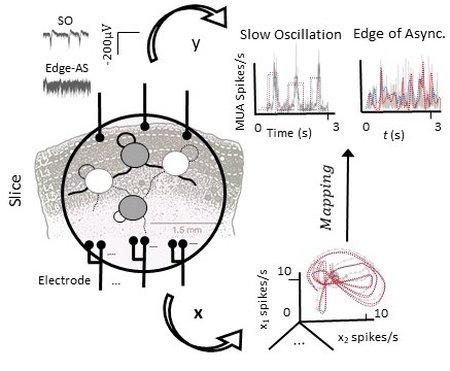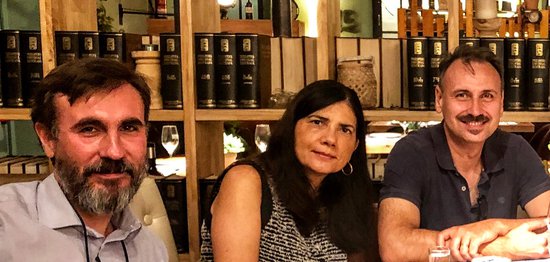Async-Prop
The project Async-Prop develops new analytical approaches for studying the propagation of spontaneous activity in confined neuronal networks. The team involves researchers from Bournemouth University in UK, the Italian Institute of Health in Rome and the Biomedical Research ‘August Pi I Sunyer’ in Barcelona; combining expertise in neurophysiology, physics and machine learning.
Consciousness is a state of self-awareness which suddenly disappears under anaesthesia or while falling asleep. However, this extended view on the abrupt emergence of the asynchronous states that underlie consciousness has been challenged by recent studies: it seems to be rather mediated by states straddling the boundary between a relatively simple rhythmic pattern during unconsciousness, and the highly complex asynchrony characterising the awake brain. Thus, understanding the dynamics of these state transitions are key to understand how consciousness emerges, one of the most exciting challenges in neuroscience and a central theme in the Human Brain Project (HBP).
Project description
In this project, we are developing new analysis tools and mechanistic models for scrutinizing this intriguing state, that we termed the near-awake state. Crucially, we generate this state in an optimally controlled biophysical environment for testing our methods: an isolated cortical slice, separated for the rest of the brain.
Objectives
Our approach is designed to comparatively analyse full, non-simplified spiking neuronal network models of activity propagation through two objectives:
1. Network models implement different biophysical hypotheses for the onset and propagation of the multi-unit activity in slices exhibiting a near- asynchronous, awake-like state.
2. Leveraging novel time-series analysis methods, we study comparatively models and cortical slices to identify the optimal neuronal network design.
Collaboration with HBP
This project is a natural partner for the subproject SP3-Systems and Cognitive Neuroscience of the Human Brain Project, and contributes to the main HBP objectives:
1. The project is designed to foster in silico network simulations, potentially informing future hardware implementations. Thus, it establishes synergies with the subproject SP9, especially with the physical model, BrainScales.
2. It will promote the efficient development of a multi-scale scaffold theory, by providing tools for optimizing network complexity at multiple detail levels.
3. The tool will also complement state-of-the-art model selection approaches, stimulating the Brain-Inspired Data Analytics field.
4. The experiments are pioneering in describing a near-awake-like state in vitro, providing insights on the nature of consciousness and thus the basis for a significant future societal impact of the approach.
Partnering Organisations

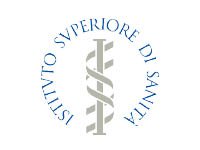
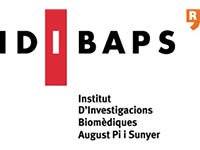
Biographies

Emili Balaguer-Ballester (Project Coordinator)
Is a physicist specialized in computational neuroscience (neuronal coding and dynamics, neural ensemble modelling and auditory perception); with a focus on machine learning approaches specifically designed for analysing neuronal responses. He is Associate Professor at Bournemouth University (BU). Before joining BU in 2012, he was postdoc and group leader at the Bernstein Centre for Computational Neuroscience Heidelberg-Mannheim (2008-2012). Previously, he was postdoc at the Centre for Theoretical Neuroscience at Plymouth University (2005-2008) and research fellow at the University of Valencia/seconded in an AI company.
Emili is Associate Editor for Frontiers in Computational Neuroscience and previously Guest Associate Editor for Frontiers in Systems Neuroscience. He was awarded a prize (Culture Institute ‘Juan Gil-Albert’, Spain) for the best PhD dissertation (2001, University of Valencia), co-edited a book and special issues in journals; and actively co-champions the interdisciplinary neuroscience research centre at Bournemouth University.
Maurizio Mattia
Physicist by training and with a PhD in Neurophysiology, he is a permanent staff Researcher at the National Center for Radiation Protection and Computational Physics of the Istit uto Superiore di Sanità (Italian Institute of Health). His main interest is in bridging the gap between theory and experimental evidence on cortical network dynamics by developing innovative data analyses and computational approaches. On this topic he published more than 30 peer-reviewed journal papers and participated to several EU funded projects. Since April 2016, he is member of the Human Brain Project as task leader.
Mavi Sanchez-Vives
Mavi Sanchez-Vives: MD, PhD in neurosciences has been ICREA Research Professor at the IDIBAPS (Institut d'Investigacions Biomèdiques August Pi i Sunyer) since 2008, where she leads the Systems Neuroscience group. She is also co-Director of the Event Lab (Experimental Virtual Environments in Neuroscience and Technology) and Adjunct Professor at the Department of Basic Psychology, University of Barcelona. Previously, she was Associate Professor of Physiology and Group Leader at the Neuroscience Institute of Alicante (Spain) (2000-2008), and postdoctoral fellow at Rockefeller (1993-1994) and Yale (1995-1999) Universities.
Prof. Sanchez-Vives is partner in the EU flagship projects Graphene and the Human Brain Project. Previously, she was coordinator of the FET project CORTICONIC, the ERA Net project, partner of a Human Frontiers project and of 8 European projects; and obtained regular funding from the Spanish Ministry of Science. She is Chief Editor of Frontiers in Systems Neuroscience since 2013 and was member of the program committee of the Spanish Society of Neuroscience (2013-2015). Throughout her research career she has been studying how neuronal and connectivity properties determines the emergent activity generated by neuronal networks by combining experimental and computational approaches, with an interest in neurotechnology.
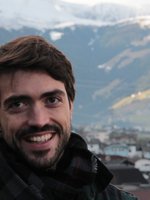
Roman Arango
Is a PhD student at Bournemouth University since 2017. His project revolves around the probabilistic study of the propagation of multi-unit activity in vitro, operating in slow oscillatory and awake-like states. Roman is a mathematician and holds an additional MSc in Bioinformatics, obtained while he was working at the Neuronal Circuits Lab, Dept. of Human Anatomy and Embryology, Faculty of Medicine (University of Valencia). Before joining BU, he was research assistant at the Institute for Health Research (INCLIVA) and at the Intelligent Data Analysis Laboratory (IDAL, University of Valencia), funded by the programme VLC-BIOCLINIC 2015.
Publications
R Arango, P Mateos-Aparicio, MV Sanchez-Vives, E Balaguer-Ballester. Propagating Densities of Spontaneous Activity in Cortical Slices. The 28th Computational Neuroscience Conference (CNS). Barcelona, 13-17th July 2019.
R Arango, P Mateos-Aparicio, MV Sanchez-Vives, E Balaguer-Ballester. Identifying Propagation Modes of Spontaneous Activity in Cortical Slices. Bernstein computational Neuroscience Conference 2018. Berlin, 25th -28th September 2018.
R Arango, P Mateos-Aparicio, MV Sanchez-Vives, E Balaguer-Ballester. Transient Dynamics of Cortical Networks Underpinning Slow Oscillations. Analysis and Modeling of Complex Oscillatory Systems Conference (AMCOS). Barcelona, 19th-23rd March 2018.
R Arango, P Mateos-Aparicio, MV Sanchez-Vives, E Balaguer-Ballester. Inference of Global States Stability in Cortical Networks. Barcelona Computational, Cognitive and Systems Neuroscience Conference (BARCC-SYN). Barcelona, 15th -16th June 2017.
E Balaguer-Ballester. 2017. Cortical variability and challenges for modelling approaches. Frontiers in Systems Neuroscience, 11:15.
Key facts
Time frame: 2017 to 2021
Origin: Spontaneous Application
Funding: Bournemouth University (UK), IDIBAPS (ES)

